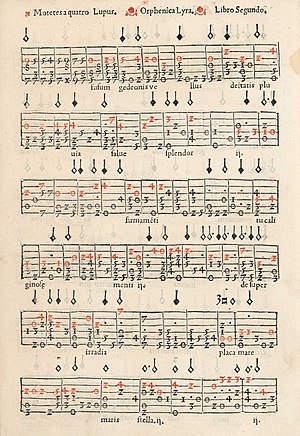This article may need to be rewritten to comply with Wikipedia's quality standards. (October 2023) |

Tablature (or tab for short) is a form of musical notation indicating instrument fingering or the location of the played notes rather than musical pitches.
Tablature is common for fretted stringed instruments such as the guitar, lute or vihuela, as well as many free reed aerophones such as the harmonica. Tablature was common during the Renaissance and Baroque eras, and is commonly used today in notating many forms of music.
Three types of organ tablature were used in Europe: German, Spanish and Italian.[1]
To distinguish standard musical notation from tablature, the former is usually called "staff notation" or just "notation".
- ^ Weiss, Piero; Taruskin, Richard (2014). Music in the Western World: A History in Documents, Study Guide. 2nd Edition. Cengage Learning. ISBN 9780534585990. Retrieved 7 June 2018.